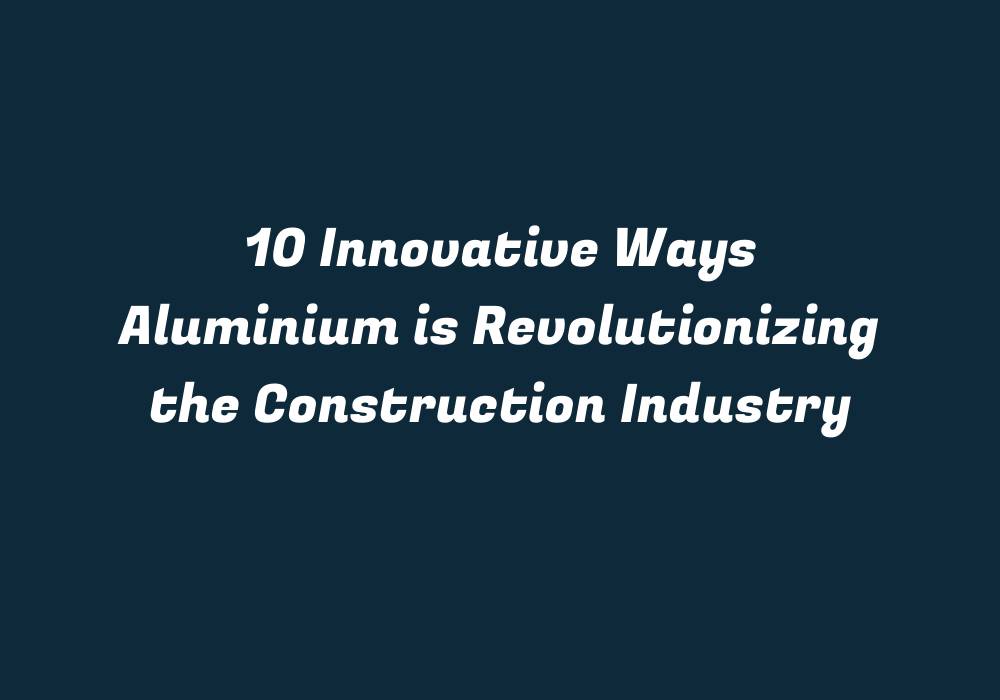Introducing Aluminium: A Game-Changer in the Construction Industry
Aluminum, a lightweight and durable metal, has been transforming various industries for years. Its remarkable properties have made it an essential component across multiple sectors such as transportation, aerospace, electronics, and now – construction. This article discusses 10 innovative ways in which aluminium is revolutionizing the construction industry.
Aluminum Composite Materials
One of the most notable innovations is the use of Aluminum Composite Materials (ACMs). These materials are created by bonding two sheets of aluminum with a non-aluminum core, such as polyethylene. The resulting product offers excellent durability, high strength, and weather resistance. Due to their lightweight nature, ACMs have become an increasingly popular option for architectural cladding in contemporary buildings.
Sustainable Construction
Aluminum is inherently recyclable and highly energy-efficient to produce, making it the perfect choice for sustainable construction projects. The metal’s long lifespan ensures that buildings incorporating aluminum components can last for decades, minimizing the need for repairs or replacements. In addition, its recyclability means that once a structure is no longer needed, aluminium can be recycled into new materials, further reducing waste and promoting sustainability.
Eco-Friendly Building Envelopes
The use of aluminum in construction contributes to the creation of eco-friendly building envelopes. This involves incorporating advanced technology to enhance insulation, weatherproofing, and thermal comfort within a structure. By optimizing energy efficiency through these features, aluminum plays a critical role in reducing carbon emissions while providing a comfortable living environment for occupants.
Safety and Security
Aluminum’s excellent corrosion resistance and low maintenance requirements make it an ideal material for ensuring the safety and security of buildings. Aluminium can be used to create protective barriers, fireproofing systems, and emergency exit doors that comply with modern construction standards. These features contribute significantly to a building’s overall safety and security.
Modular Construction
Aluminum’s lightweight and flexible nature has allowed it to be seamlessly integrated into modular construction methods, which involve the fabrication of pre-assembled units in a factory setting. These units are then transported to the building site for assembly, reducing construction time and waste. By utilizing aluminium in this manner, architects can create more innovative designs with faster turnaround times.
Adaptable Design Solutions
Aluminum’s adaptability allows architects to design structures that respond to changing environmental conditions and user needs. Its flexibility enables the creation of movable partitions, folding walls, adjustable window frames, and other features that can be easily modified as required. This adaptability leads to more flexible living spaces, enhancing a building’s overall functionality and user experience.
Innovative Structures
From eye-catching facades and complex geometric forms to sustainable roof designs, aluminum has enabled architects to push the boundaries of traditional construction techniques. Its versatility allows for the creation of unique, cutting-edge structures that are both visually appealing and functional. These innovative designs have made a significant impact on the built environment and showcase the true potential of aluminium as a revolutionary material in construction.
Improved Energy Efficiency
Aluminum’s thermal properties contribute to increased energy efficiency in buildings. By incorporating it into building envelopes, solar shading systems, and insulated panels, architects can reduce heat transfer and minimize the amount of energy needed for heating and cooling purposes. These innovations not only lower utility costs but also contribute to a more sustainable built environment.
Low Maintenance
The use of aluminum in construction reduces maintenance requirements, allowing architects to focus on other aspects of the building’s functionality. Its corrosion resistance and durability mean that aluminium components require less upkeep than other materials, resulting in cost savings over time for both builders and property owners.
Enhancing Community Spaces
From public parks to community centers, the use of aluminum in construction is transforming shared spaces into vibrant, welcoming environments that foster social interaction and support the development of close-knit communities. Aluminium’s versatility and sustainability enable architects to create dynamic designs that promote wellbeing and improve overall quality of life.
Conclusion
Innovative ways in which aluminum is revolutionizing the construction industry have significantly impacted every aspect, from design to safety and sustainability. By embracing the possibilities offered by this versatile material, architects can create more efficient and eco-friendly structures that meet the demands of modern living and promote a healthier environment for generations to come.
Aluminum is transforming construction in numerous ways, making it an essential element in sustainable design, enhanced safety, innovative building techniques, and community development. This adaptable material continues to drive positive change across the construction landscape, solidifying its status as a revolutionary force within the industry.
